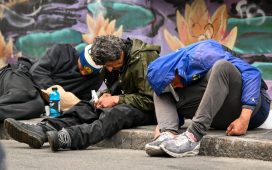For decades, a growth the size of a large melon made Raymondo Okir’s life miserable. Okir, who lives in a village in northern Uganda, first noticed the swelling around his genitalia in 1983. Within a year, the mass had grown large enough that he developed back pain and found it hard to wear trousers and to have sexual relations with his wife.
“Everyone would look and laugh at me and I felt inferior. It grew quickly,” says Okir, 78. “I felt fear. It was hard to dress. I had a lot of back and waist pain and many issues with my wife. Our relationship wasn’t going well. I was scared to go out in public.”
Other people in his village had similar growths, including his two brothers, but none sought medical attention. Then, in 2021, Okir attended a burial where the village elders told him he had a hydrocele (scrotal swelling), a symptom of lymphatic filariasis (LF), and that surgery would help him. He went to get treatment; during the operation, the medical team drained about three litres of fluid from the swelling around his scrotum.
LF, which can be painful and disfiguring, is transmitted through the bites of infected mosquitoes. It is included on the World Heath Organization’s (WHO) list of neglected tropical diseases. At the end of 2022, 794 million people were living in areas considered at risk for infection throughout Asia, Africa, the western Pacific, and parts of the Caribbean and South America, while 51.4 million people were estimated to be infected in 2018. The disease is seen in the most marginalised populations in rural areas with poor infrastructure, housing, water and sanitation.
Infection usually happens in childhood, damaging the lymphatic system. The profoundly disfiguring manifestations of the disease – lymphoedema (tissue swelling) or elephantiasis (skin/tissue thickening) of limbs and hydrocele (scrotal swelling) – occur later in life. At least 36 million people remain with these chronic disease manifestations.
The WHO-recommended strategy for eliminating the disease is to roll out drug prevention treatments to at-risk populations and to care for those affected. There is no cure for lymphoedema but self-care can help relieve pain and prevent further swelling – improving people’s mobility. Hydroceles can be treated with surgery to drain the fluid.
Since Okir had his operation, life has improved. “I no longer have back pain,” he says. “I can have sex very, very well. When I go in the village and to church, people [who used to laugh at me] are quiet. I point at them, and ask, ‘Can you see [my hydrocele]?’”
Dr Charles Wamboga, lead on LF at Uganda’s Ministry of Health, has heard similar stories. “There are those who come back and tell us, ‘I’ve been able to get back my family; I’ve been able to do some digging in my garden; I can go to the market and sell things, which I used not to do.’”
Efforts to tackle the disease in Uganda began in the late 90s, Wamboga says, after a newspaper story about an association of people with hydroceles who believed they were a sign of wealth.
Officials carried out studies to determine how many people were affected; up to 17 million people were thought to be at risk and 6 million, close to a third of the population at the time, were estimated to have the disease, he says.
Since then, several rounds of mass drug administration have been carried out in affected communities, and authorities have been monitoring transmission. Efforts are now focused on managing lymphoedema and hydrocele surgery.
There are still tens of thousands of people living with, and receiving no treatment for, lymphoedema and hydrocele in Uganda, according to Sightsavers, an international NGO that has provided training to medical professionals performing surgery.
after newsletter promotion
Dr James Olum, a senior medical officer at Orum health centre in Otuke, a town in northern Uganda, was trained by Sightsavers to carry out operations. He notices common traits in his patients. “Most people who come for treatment are lonely. That’s the story they tell,” he says. “Most of them tell me they have issues with their marriages. Some of them have broken marriages … Most of the people I see are poor.”
While more people are coming forward, Olum says, there are others who don’t seek help and the stigma keeps many from going out in public. Swelling is sometimes seen as a sign of witchcraft. Health centres also have other priorities, such as maternal and child health, and so cannot always dedicate resources to LF, he adds.
The WHO considers that 21 countries, out of 72 where LF is endemic, have eliminated it as a public health problem. Progress has been encouraging, says Jonathan King, team lead on the WHO’s neglected tropical diseases programme. “Since the inception of the programme for LF elimination [countries] have done quite well,” he says. “There’s still a lot of work to be done, but compared to some of the other neglected tropical diseases, it has progressed.”
One factor has been pharmaceutical companies, including GSK and MSD, donating WHO-recommended medicines for free. “They deserve a lot of credit. This is good what they’ve done, and LF in particular has seen a lot of impact from [these medicines],” says King.
There are 51 countries that have not eliminated LF. All but 10 of these should be able to stop mass drug administration by 2030, says King, while 23 more should be able to achieve elimination (in addition to the 21 already validated).
Back at Orum health centre in Uganda, Okir remains happy and grateful for his surgery. He says his relationship with his wife is better and that, unlike before, she makes him porridge in the morning. “She shows me lots of love,” he says. He has been encouraging others to seek treatment. His son, who also had a hydrocele, has been operated on, as well as two other men from his village.
“I explained the good side of it, that is why they turned up [at the health centre],” he says. “If I could go back in time, I would have come and got surgery earlier. I feel so good. I’m free.”








